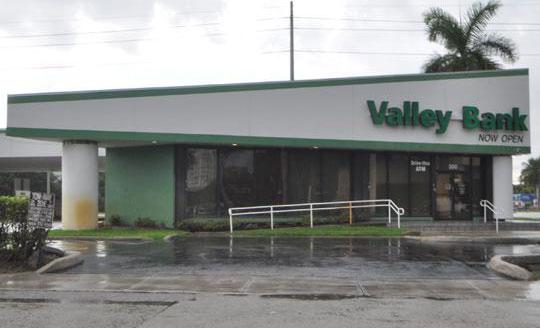By Christopher Menkin

These two bank failures are related as they share the same holding company. The South Florida Business Journal reports that River Valley Bancorp gave the Fort Lauderdale bank $4.25 million in the first quarter of 2013 to essentially keep it alive. Both banks were poorly run, and their troubles included poor commercial lending practices. as poor administration, as determined by the many FDIC write-ups.

The larger of the two, the 13 branches of Valley Bank, Moline, Illinois, were closed with Great Southern Bank, Reeds Spring, Missouri, to assume all of the deposits. Founded March 1, 1911, the bank had 145 full time employees as of March 31, 2014, at its 16 offices. They had their original office in Moline, and 15 in Iowa: three, Davenport; two, Ames; two Bettendorf, one each in Altoona, Ankeny, Cedar Falls, Clive, Eldridge, Knoxville, Oskaloosa, and Pleasant Hill. Year-end 2006, the bank had 198 full time employees.
Tier 1 risk-based capital ratio 1.07%
This is more an Iowa bank, with the holding company and Valley Bank CEO Dennis Hansont located in Davenport, Iowa, as well as 15 of the branches in Iowa, not Illinois.
The bad loans were not residential or construction related, but more loose business loans, resulting in high non-current loans, and note the charge offs.
(In millions, unless otherwise)
Non-Current Loans
2006 $368,000
2007 $8.2
2008 $11.4
2009 $7.0
2010 $18.1
2011 $6.0
2012 $10.0
2013 $27.9
3/31 $49.6
Charge Offs
2006 $164,000 ($69,000 commercial/ind., $69,000 1-4 family, $48,000 other, $$37,000 construction, -$72,000 multifamily)
2007 $637,000 ($295,000 1-4 family, $259,000 multifamily, $73,000 other loans, $13,000 individual, -$134,000 commercial/industrial
2008 $6.5 ($1.5 1-4 family, $1.4 commercial/ind., 1.0 nonfarm/nonres, $229,000 individual, $206,000 multifamily, $169,000 other loans
2009 $3.8 ($1.2 construction/land, $1.2 commercial/ind., $650,000 1-4 family, $303,000 multifamily, $178,000 individuals. $157,000 other loans, $68,000 nonfarm/nonres.)
2010 $5.2 ($1.6 construction/land, $1.4 1-4 family, $1.1 commercial/industrial, $936,000 nonfarm/nonres., $36,000 other loans)
2011 $26.3 ($15.5 commercial/industrial, $5.2 nonfarm/nonres., $3.4 construction/land, $1.2 multifamily, $957,000 1-4 family, $69,000 individuals, $21,000 other loans
2012 $2.7 ($1.6 commercial/industrial, $$632,000 nonfarm/nonres., $297,000 1-4 family,
$86,000 construction/land, $10,000 other, -$1,000 individuals)
2013 $8.1 ($5.4 commercial/industrial, $1.4 construction/land, $684,000 nonfarm/nonres.,
$450,000 1-4 family, $106,000 multifamily, $27,000 other loans, $19,000 individuals)
3/31 $1.1 ($1.00 commercial/industrial, $154,000 1-4 family, $7,000 individuals, $2,000 construction/land, -$8,000 nonfarm/nonres.)
Construction and Land, 1-4 family multiple residential, Multiple Family Residential, Non-Farm Non-Residential loans.
Net Equity
2006 $43.0
2007 $47.0
2008 $51.7
2009 $54.6
2010 $51.8
2011 $25.0
2012 $17.9
2013 $7.0
3/31 $3.1
Profit
2006 $5.4
2007 $4.8
2008 $2.0
2009 $204,000
2010 -$2.5
2011 -$26.9
2012 -$7.1
2013 -$10.4
3/31 -$4.4
As indicated in the large $26.9 loss reported in 2011, this was due to an audit of the books by the FDIC, and a re-write of loans and other entries. In reality, the bank was trying to raise capital and stalled off its demise as another "Zombie" bank.
As of March 31, 2014, Valley Bank had approximately $456.4 million in total assets and $360.0 million in total deposits. In addition to assuming all of the deposits of Valley Bank, Great Southern Bank agreed to purchase approximately $375.4 million of the failed
bank's assets. The FDIC will retain the remaining assets for later disposition.
The FDIC estimates that the cost to the Deposit Insurance Fund (DIF) will be $51.4 million.
http://www.fdic.gov/news/news/press/2014/pr14047.html
* "A zombie bank is a financial institution that has an economic net worth less than zero but continues to operate because its ability to repay its debts is shored up by implicit or explicit government credit support. The term was first used by Edward Kane in 1987 to explain the dangers of tolerating a large number of insolvent savings and loan associations and applied to the emerging Japanese crisis in 1993. A zombie can continue to operate and even to grow as long as creditors remain confident in the relevant government's ability to extract the funds needed to back up its promises from current or future taxpayers. But when this ability seems doubtful, zombie institutions face runs by uninsured depositors and margin calls from counterparties in derivatives transactions."
en.wikipedia.org/wiki/Zombie_bank

The five branches of Valley Bank, Fort Lauderdale, Florida, were closed with Landmark Bank, National Association, Fort Lauderdale, Florida, to assume all of the deposits. Founded October 15, 1974, the bank had 11 full time employees as of March 31, 2014 at its two offices in Fort Lauderdale, one each in Davie, Hollywood, and Tamarac. Year-end 2007, the bank had 24 full time employees, its highest number.
Tier 1 risk-based capital ratio 0.87%
(In millions, unless otherwise)
Net Equity
2006 $13.9
2007 $15.2
2008 $15.5
2009 $13.5
2010 $9.9
2011 $6.0
2012 $646,000
2013 $1.4
3/31 $436,000
Profit
2006 -$42,000
2007 $65,000
2008 $18,000
2009 -$1.9
2010 -$3.7
2011 -$5.3
2012 -$4.9
2013 -$970,000
3/31 -$1.0
Non-Current Loans
2006 $858,000
2007 $961,000
2008 $2.1
2009 $2.3
2010 $3.4
2011 $3.7
2012 $848,000
2013 $5.1
3/31 $8.2
Charge Offs
2006 $122,000 ($67,000 commercial/industrial, $37,000 1-4 family, $18,000 individuals)
2007 $304,000 ($300,000 1-4 family, $49,000 individual, -$45,000 commercial/industrial)
2008 $606,000 ($514,000 1-4 family, $63,000 commercial/ind, $29,000 individual)
2009 $1.3 ($912,000 commercial/industrial, $435,000 1-4 family, $4,000 indiv., $8,000 other).
2010 $1.5 ($548,000 constr./land, $481,000 commercial/indus., $276,000 1-4 family,
$124,000 nonfarm/nonres.-$3,000 individual)
2011 $5.2 ($2.6 commercial/industrial, $1.3 nonfarm/nonres., $681,000 1-4 family, $231,000 multifamily, -$4,000 individual)
2012 $217,000 ($125,000 nonfarm/nonres., $90,000 1-4 family, $25,000 commercial/industrial,
-$23,000 individual)
2013 $1.7 ($568,000 nonfarm/nonres., $510,000 constr./land, $325,000 multifamily, $175,000 commercial/industrial, $112,000 1-4 family
3/31 $2,000 ($2,000 construction/land).
Construction and Land, 1-4 family multiple residential, Multiple Family Residential, Non-Farm Non-Residential loans.
As of March 31, 2014, Valley Bank had approximately $81.8 million in total assets and $66.5 million in total deposits. In addition to assuming all of the deposits of Valley Bank, Landmark Bank, National Association agreed to purchase essentially all of the failed bank's assets.
The FDIC estimates that the cost to the Deposit Insurance Fund (DIF) will be $7.7 million.
www.fdic.gov/news/news/press/2014/pr1404...
List of Bank Failures:
http://www.fdic.gov/bank/individual/failed/banklist.html
Leasing News Bank Beat:
http://www.leasingnews.org/Conscious-Top%20Stories/Bank_Beat.htm
Disclosure: The author has no positions in any stocks mentioned, and no plans to initiate any positions within the next 72 hours.